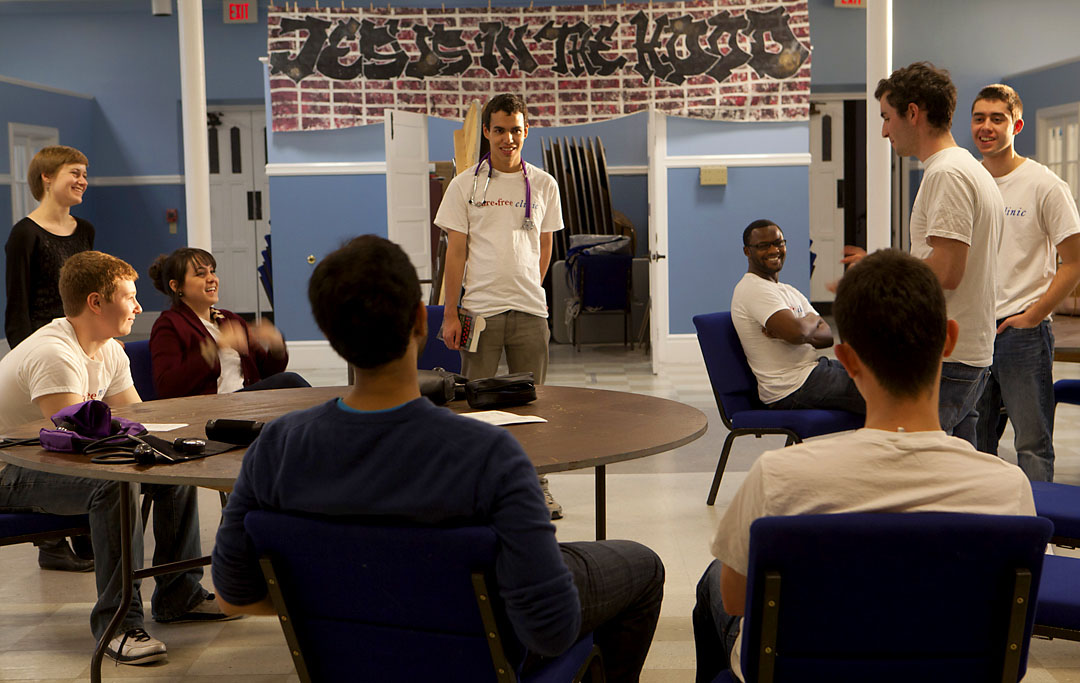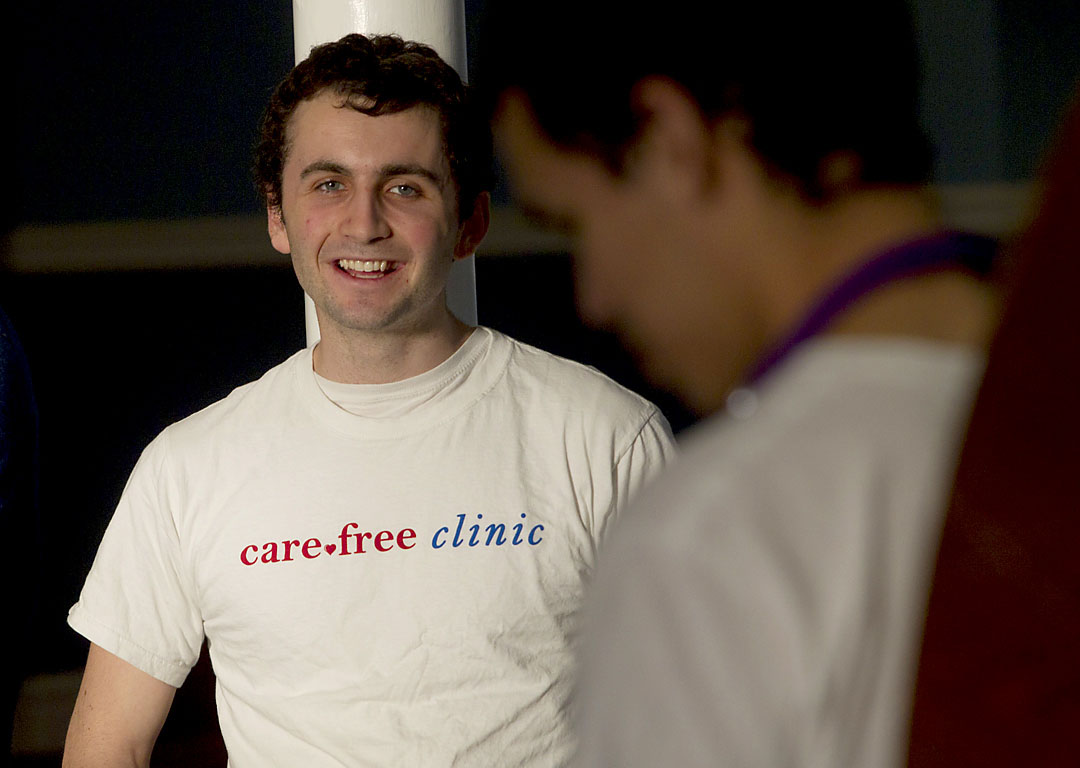At most times of day the Gloria Dei Lutheran Church on Hayes Street would be almost literally overshadowed by the Statehouse to its immediate east or Providence Place to its south. But on a recent February afternoon the sun shone over I-95 through the western window of its multipurpose room and right on to the chair where a man named Imoteo sat down.
When he did, biology sophomore Will Barbosa wrapped the velcro cuff of a sphygmomanometer around his arm as part of a free health screening provided by a team of Brown University undergraduates holding the CareFree Clinic.
Imoteo came with his wife. When the clinic’s doors opened at 4 p.m., four others, including at least one other couple, were already waiting at the door. Student volunteers told patients that for more free health services they could go to Clinica Esperanza on Valley Street, just a few blocks north of where Broadway meets Westminster. Imoteo only spoke Spanish, but that was no problem. Like many of CareFree Clinic’s two dozen volunteers, Barbosa, who is a native of Puerto Rico, did too.
The CareFree Clinic, which held its first session last fall, is the newest of several efforts Brown undergraduates undertake to contribute to health and welfare in the city they adopt for the four years of their education. The students leading these efforts say they couldn’t just hang around the dorms and dining halls when there are so many opportunities to help people nearby.

“One of the things that inspires me about medicine after starting this group up is how much of a difference a few doctors, or even a few college students, can make,” said biology and French sophomore Garret Johnson, of Boxford, Mass. The son of a doctor and a nurse practitioner has worked to recruit the volunteers, collect equipment, forge partnerships with Gloria Dei and Clinica Esperanza, and spread the word about the free blood pressure screenings. His team’s methods range from Twitter and Facebook to leafleting at Kennedy Plaza.
Meeting needs
The CareFree Clinic volunteers are hardly alone. Their altruistic spirit is shared, for example, by the students who volunteer for Health Leads, a program that helps improve the access low-income families have to the basic resources they need to be healthy. Through the program, doctors at Hasbro Children’s Hospital’s outpatient clinic and pediatric emergency department can “prescribe” food, housing, child care, and other services for their patients by referring them to Health Leads volunteers. The students then help families fill those prescriptions by connecting them to community resources, public programs, job training opportunities, and other services.
“Addressing health is fundamental,” said Amalia Gonzalez a neuroscience senior from Guilford, Conn. “Having access to healthcare through insurance is just a very small fraction of what contributes to someone’s health. Health is determined by a confluence of different factors and can only be supported well if you have a baseline level of access to many different things like housing, education, and transportation.”
Health Leads, a national nonprofit, expects to serve about 1,400 families through its Providence chapter with about 60 student volunteers from Brown, said student coordinator Amy Traver of Darien, Conn., a Human Biology concentrator in her senior year. Student volunteers staff a desk at the Hasbro clinic from 9 a.m. to 4:30 p.m. Monday to Friday and in the emergency department for a couple of hours every weeknight.
Traver still remembers one of the first families she helped: a man from Liberia and his 1-year-old daughter. The man had lost his immigration papers and that had held back his employment opportunities. He and his daughter were uninsured, and he was having trouble paying for food and formula.
“What was most shocking to me as a new volunteer was when he told me that he didn’t have a crib for this 1-year-old. She was just sleeping in the bed with him,” Traver said. “A lot of things can take a lot of time, especially immigration issues, but we were able to find him a crib for his daughter within about 10 days or two weeks with the Rhode Island Donation Exchange.

“A lot of times families don’t believe that there is anything out there that can help them, so when you do find something like a crib — he just really couldn’t believe he was going to finally have that for his daughter,” she said.
Students who teach
Human biology junior Kelsey Collins, too, has worked with a struggling parent in her volunteer work, but in her case the parent was a girl who’d become pregnant at 13. That’s how dramatic the stakes can be for sex education among teenagers. That’s the cause that Collins works on along with fellow student volunteers at five Providence campuses of the Metropolitan Regional Career and Technical Center, or the MET School, a publicly funded network of six charter schools in Providence and Newport.
Collins is a coordinator for the program SHAPE (Sexual Health Advocacy through Peer Education). Like Health Leads, the program is affiliated with Brown’s Swearer Center for Public Service.
After training, the 20 Brown student SHAPE volunteers either teach directly or train MET School students to teach state-required sexual education classes. The program provides a way for the MET school to meet those mandates well and at a low cost, Collins said.
Collins met the teen mom at the MET School when the girl was 17 and her son was 3 years old. She was motivated to help her peers by her experience and by having taken SHAPE classes. She wanted to participate as a peer educator.
SHAPE offers two levels of curriculum to MET students, whether the advisory sessions are led by the Brown volunteers or the MET students they train. For ninth or tenth graders SHAPE teachers help the high schoolers learn the “nuts and bolts,” subjects such as sex, pregnancy, contraception, and sexually transmitted infections. The second level, for juniors and seniors, explores more sophisticated topics such as body image, gender and sexuality, and the way people are exposed to sexuality in the media.
In her Brown classes Collins focuses on women’s and sexual health. Joining SHAPE, she said, has been especially rewarding as students advance in their understanding from what they hear from each other to what they learn in class.
“Once I actually started working with the students, I loved it,” she said. “It is my favorite thing in the world. I’m so happy with the students I get to work with. This is one of those community service experiences where you really feel like you have a huge impact.”
CareFree inspiration
Impact is the major motivation for volunteers. The CareFree Clinic’s Johnson said there is more need in many cities than established institutions, whether government or nonprofit, can meet. It’s therefore important for more volunteers to take responsible action. That motivation took hold last summer while he was working a job, helping with the morning cleanup at a restaurant in Boston. He mopped and wiped side-by-side with a man named Wilson, who had immigrated from Colombia a few years before.
“He had never had his blood pressure taken in the United States and didn’t have a doctor,” Johnson said. “I started thinking about it and I knew at other colleges there were groups that undergrads could get involved with and directly deal with patients.”
He came back to Brown resolved to start such a group. He sent a message through Morning Mail to all undergrads to see if others shared that interest. More than 130 people responded. Ultimately he culled the list down to 25 students who either speak Spanish or have EMT training. But the overwhelming interest in his and other groups like Health Leads and SHAPE suggest that when it comes to the community, many Brown students are here to help.

